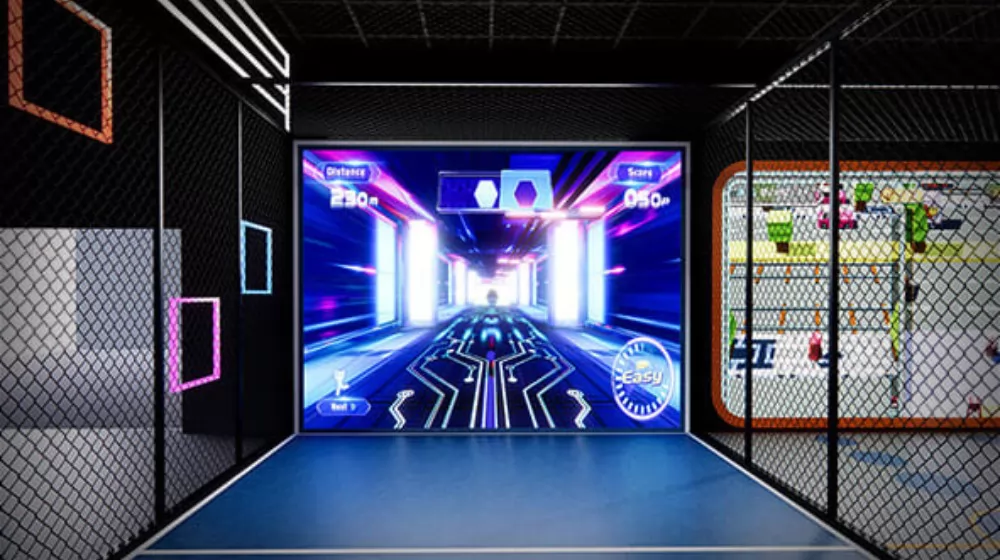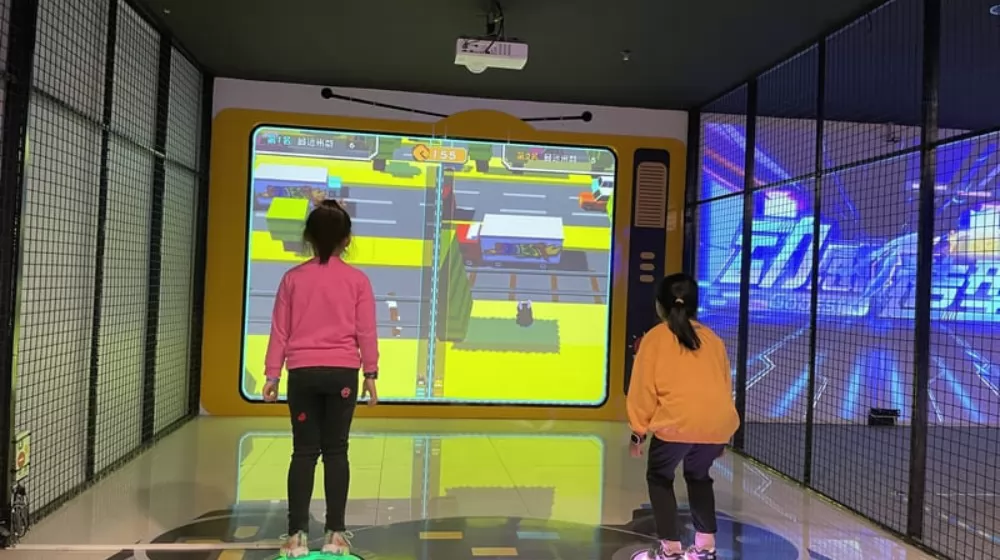
In today's fast-paced digital world, interactive wall games have emerged as a revolutionary technology, transforming the way we engage with our surroundings. From educational environments to entertainment venues, these interactive experiences captivate audiences, blending technology and creativity seamlessly. Whether it's enhancing learning, boosting physical activity, or simply providing fun, interactive wall games are making a significant impact across various sectors. Join us as we dive deep into the world of interactive wall games, exploring their principles, types, benefits, and how to choose the right one for your needs.
What are Interactive Wall Games?
Interactive wall games are an innovative form of entertainment and education that utilize interactive projection technology to transform ordinary walls into engaging and dynamic play surfaces. These games are designed to respond to human interaction, making them not just visually captivating but also highly interactive and immersive. By using sensors, projectors, and sophisticated software, interactive wall games can detect motion, touch, and gestures, creating a seamless and interactive experience for users.
Imagine walking into a room where the walls come to life with vibrant colors and exciting animations. As you move closer, the wall responds to your presence, inviting you to participate in various activities. Whether it's a game that challenges your reflexes, an educational activity that teaches new concepts, or a creative application that lets you draw and design, interactive wall games offer endless possibilities for engagement and learning.
These games are particularly popular in settings such as schools, museums, retail environments, and public spaces, where they attract and engage a wide audience. For businesses, interactive wall games provide a unique opportunity to create memorable experiences for customers, driving foot traffic and enhancing brand loyalty. In educational contexts, they offer a hands-on learning tool that can make complex subjects more accessible and enjoyable for students.
The technology behind interactive wall games is sophisticated yet user-friendly. It typically involves a combination of high-definition projectors, motion sensors, and interactive software. The projectors display images and animations onto the wall, while the sensors track the movements and actions of the users. The software then processes this data in real time to create an interactive experience that is both responsive and engaging.

The Growing Popularity and Significance of Interactive Wall Games
Interactive wall games have witnessed a significant rise in popularity over recent years, captivating audiences across various sectors. Their appeal lies in their ability to blend entertainment, education, and interactive technology into a single, engaging experience. This surge in popularity is fueled by several key factors that highlight the growing significance of these innovative games.
One of the primary drivers behind the increasing popularity of interactive wall games is the rapid advancement in technology. Modern interactive projection systems are more advanced, affordable, and accessible than ever before. High-definition projectors, sophisticated motion sensors, and intuitive software have made it possible to create highly responsive and immersive environments. As a result, businesses and educational institutions are increasingly adopting this technology to enhance their offerings.
In educational settings, interactive wall games have proven to be an effective tool for engaging students and enhancing the learning experience. Traditional teaching methods can sometimes fail to capture the interest of all students, but interactive wall games offer a hands-on approach that appeals to different learning styles. By turning lessons into interactive experiences, these games make learning fun and memorable, helping students to retain information better and develop a love for learning.
Retailers and businesses have also recognized the potential of interactive wall games to attract and retain customers. In an increasingly competitive market, providing unique and memorable experiences can set a business apart. Interactive wall games can transform a retail space into an immersive environment that entertains customers while promoting products and services. This not only increases foot traffic but also encourages customers to spend more time in the store, thereby increasing the likelihood of purchases.
Public spaces and recreational areas have embraced interactive wall games as well. Parks, museums, and community centers use these games to engage visitors and enhance their experiences. Interactive wall games in these settings serve as a magnet for families and children, providing a fun and educational activity that can be enjoyed by people of all ages. This widespread adoption has cemented their place as a valuable addition to public and recreational spaces.
Furthermore, the COVID-19 pandemic has accelerated the adoption of contactless technologies, including interactive wall games. As people became more cautious about physical interactions, the demand for touchless and socially distant entertainment options grew. Interactive wall games fit this requirement perfectly, as they can be controlled through gestures and movements without the need for physical contact. This has made them a popular choice for safe and engaging entertainment during the pandemic and beyond.
The Basic Principles Behind Interactive Wall Technology
Touchscreen Technology
At the core of interactive wall technology is the integration of touchscreen capabilities. These systems often utilize capacitive or resistive touchscreens, which can detect and respond to touch inputs. Capacitive touchscreens work by detecting changes in the electrostatic field caused by the user's touch, while resistive touchscreens rely on pressure applied to the surface. These touchscreens enable users to interact directly with the displayed content, providing an intuitive and engaging experience.
Motion Sensors and Cameras
Motion sensors and cameras play a crucial role in enhancing the interactivity of wall games. These devices track the movements and gestures of users, allowing the system to respond accordingly. Infrared sensors, ultrasonic sensors, and depth cameras are commonly used to capture motion data. Infrared sensors detect heat signatures, ultrasonic sensors measure the distance of objects using sound waves, and depth cameras create a 3D map of the environment. By analyzing this data, interactive wall systems can accurately interpret user actions and provide real-time feedback.
Projection Systems
High-definition projection systems are essential for delivering the visual components of interactive wall games. These projectors display vivid images and animations on the wall, creating an immersive visual experience. Short-throw or ultra-short-throw projectors are often used to minimize shadows and ensure a clear display even in small spaces. Additionally, advanced projection mapping techniques can be employed to align the projected content with the physical surface, enhancing the realism and immersion of the interactive experience.
Software and Platforms
The software and platforms behind interactive wall games are the brains of the operation, orchestrating the various hardware components to create a cohesive and engaging experience. These software solutions manage everything from touch inputs and motion detection to content rendering and game logic. By leveraging sophisticated algorithms and machine learning, the software can deliver highly responsive and interactive experiences that adapt to user actions in real time.
Common Software Used in Interactive Wall Games
Several software platforms are commonly used to develop and run interactive wall games. Some of the most popular include Unity, Unreal Engine, and custom-built applications. Unity and Unreal Engine are powerful game development engines that offer a wide range of tools and features for creating interactive experiences. They support various input methods, including touch and motion sensors, and provide high-quality graphics and physics simulations. Custom-built software, tailored to specific applications and requirements, is also widely used to achieve unique and optimized interactive experiences.
Platform Compatibility and Integration
Ensuring platform compatibility and integration is crucial for the seamless operation of interactive wall systems. These systems need to work harmoniously with various hardware components and software platforms. Compatibility with different operating systems, such as Windows, macOS, and Android, is often required. Integration with other technologies, such as Internet of Things (IoT) devices and cloud-based services, can further enhance the functionality and versatility of interactive wall games. By supporting a wide range of platforms and ensuring smooth integration, interactive wall technology can deliver a consistent and high-quality user experience across different environments and use cases.

The Basic Principles Behind Interactive Wall Technology
Touchscreen Technology
At the core of interactive wall technology is the integration of touchscreen capabilities. These systems often utilize capacitive or resistive touchscreens, which can detect and respond to touch inputs. Capacitive touchscreens work by detecting changes in the electrostatic field caused by the user's touch, while resistive touchscreens rely on pressure applied to the surface. These touchscreens enable users to interact directly with the displayed content, providing an intuitive and engaging experience.
Touchscreen technology has evolved significantly over the years, becoming more sensitive and accurate. Modern touchscreens can detect multiple points of contact simultaneously, known as multi-touch technology, allowing for complex gestures such as pinching, swiping, and rotating. This multi-touch capability enhances the interactivity of wall games, enabling more dynamic and engaging user experiences. For instance, players can use both hands to interact with different parts of the screen, or multiple users can collaborate on a single game, fostering social interaction and teamwork.
Motion Sensors and Cameras
Motion sensors and cameras play a crucial role in enhancing the interactivity of wall games. These devices track the movements and gestures of users, allowing the system to respond accordingly. Infrared sensors, ultrasonic sensors, and depth cameras are commonly used to capture motion data. Infrared sensors detect heat signatures, ultrasonic sensors measure the distance of objects using sound waves, and depth cameras create a 3D map of the environment. By analyzing this data, interactive wall systems can accurately interpret user actions and provide real-time feedback.
The integration of motion sensors and cameras into interactive wall games opens up a world of possibilities for user interaction. These technologies enable users to control games and applications through natural movements and gestures, creating a more immersive and intuitive experience. For example, a player can wave their hand to swat at virtual objects, or use body movements to navigate through a digital environment. This level of interaction not only makes the games more engaging but also provides a workout, combining entertainment with physical activity.
Projection Systems
High-definition projection systems are essential for delivering the visual components of interactive wall games. These projectors display vivid images and animations on the wall, creating an immersive visual experience. Short-throw or ultra-short-throw projectors are often used to minimize shadows and ensure a clear display even in small spaces. Additionally, advanced projection mapping techniques can be employed to align the projected content with the physical surface, enhancing the realism and immersion of the interactive experience.
Projection technology has advanced significantly, offering higher resolutions, brighter images, and more accurate color reproduction. Laser projectors, for instance, provide sharper images and longer lifespans compared to traditional lamp-based projectors. Furthermore, some systems incorporate interactive projection surfaces that can detect touch and gestures, eliminating the need for additional sensors. This all-in-one approach simplifies the setup and enhances the user experience by providing seamless interaction with the projected content.
Software and Platforms
The software and platforms behind interactive wall games are the brains of the operation, orchestrating the various hardware components to create a cohesive and engaging experience. These software solutions manage everything from touch inputs and motion detection to content rendering and game logic. By leveraging sophisticated algorithms and machine learning, the software can deliver highly responsive and interactive experiences that adapt to user actions in real time.
Common Software Used in Interactive Wall Games
Several software platforms are commonly used to develop and run interactive wall games. Some of the most popular include Unity, Unreal Engine, and custom-built applications. Unity and Unreal Engine are powerful game development engines that offer a wide range of tools and features for creating interactive experiences. They support various input methods, including touch and motion sensors, and provide high-quality graphics and physics simulations. Custom-built software, tailored to specific applications and requirements, is also widely used to achieve unique and optimized interactive experiences.
Unity and Unreal Engine both offer extensive libraries of pre-built assets and plugins, making it easier for developers to create interactive wall games. These platforms also support cross-platform deployment, allowing games to run on various devices and operating systems. Additionally, they offer robust community support and regular updates, ensuring that developers have access to the latest features and improvements.
Platform Compatibility and Integration
Ensuring platform compatibility and integration is crucial for the seamless operation of interactive wall systems. These systems need to work harmoniously with various hardware components and software platforms. Compatibility with different operating systems, such as Windows, macOS, and Android, is often required. Integration with other technologies, such as Internet of Things (IoT) devices and cloud-based services, can further enhance the functionality and versatility of interactive wall games. By supporting a wide range of platforms and ensuring smooth integration, interactive wall technology can deliver a consistent and high-quality user experience across different environments and use cases.
Platform compatibility extends to the ability to integrate with existing systems and networks. For instance, in a school environment, interactive wall games might need to connect to the institution’s network for content updates and data tracking. Similarly, in retail settings, integration with point-of-sale systems and customer relationship management (CRM) software can provide valuable insights and enhance the customer experience. The flexibility to integrate with various platforms and systems ensures that interactive wall games can be tailored to meet the specific needs of different users and environments.
Types of Interactive Wall Games
Educational Interactive Wall Games
Educational interactive wall games are designed to make learning engaging and fun by integrating educational content with interactive technology. These games can cover a wide range of subjects, including math, science, language arts, and history. By transforming traditional educational materials into interactive experiences, these games help students better understand and retain information.
One popular example is the interactive wall game that teaches math concepts through interactive puzzles and challenges. Students can solve equations, visualize geometric shapes, and practice arithmetic in a dynamic and immersive environment. Another example is language learning games, where students interact with words and sentences, improving their vocabulary and grammar skills through interactive exercises.
The benefits of educational interactive wall games extend beyond engagement. These games cater to various learning styles, allowing students to learn at their own pace and in a way that suits them best. They also promote critical thinking and problem-solving skills by presenting challenges that require active participation and creative solutions. Additionally, the interactive nature of these games encourages collaboration and teamwork among students, fostering a positive and inclusive learning environment.
Entertainment and Recreational Interactive Wall Games
Entertainment and recreational interactive wall games are designed to provide fun and engaging experiences for users of all ages. These games often feature vibrant graphics, exciting storylines, and interactive elements that keep players entertained for hours. Popular genres include action, adventure, puzzle, and simulation games, each offering unique features and gameplay mechanics.
One popular type of entertainment interactive wall game is the augmented reality (AR) game, where digital content is overlaid onto the real world. Players can interact with virtual characters and objects as if they were part of their physical environment. Another popular category is motion-controlled games, where players use their body movements to control the game, providing an immersive and physically active gaming experience.
These games are not only fun but also promote social interaction and teamwork. Many interactive wall games support multiplayer modes, allowing friends and family to play together. This social aspect enhances the gaming experience, making it a popular choice for parties, events, and public spaces. Moreover, the novelty and excitement of interactive wall games make them a powerful tool for attracting and retaining customers in retail and entertainment venues.
Fitness and Health Interactive Wall Games
Fitness and health interactive wall games are designed to promote physical activity and healthy living. These games combine exercise with interactive gameplay, providing a fun and motivating way to stay active. By turning workouts into games, these interactive wall systems make fitness more accessible and enjoyable for people of all ages and fitness levels.
One example of a fitness interactive wall game is the virtual dance class, where users follow dance routines projected onto the wall. The game tracks their movements, providing real-time feedback and scores based on their performance. Another example is interactive workout games, where players perform various exercises, such as squats, lunges, and jumping jacks, to progress through the game. These games often include fitness challenges and goals, motivating users to stay consistent and achieve their fitness targets.
The benefits of fitness interactive wall games are numerous. They provide a full-body workout, improving cardiovascular health, strength, and flexibility. By incorporating elements of fun and competition, these games help users stay motivated and engaged, reducing the likelihood of exercise boredom and burnout. Additionally, they offer a convenient way to exercise at home or in community centers, making fitness more accessible to a wider audience.

Key Considerations in Designing Interactive Wall Games
Development Process
Designing an interactive wall game involves a meticulous development process that ensures the final product is engaging, functional, and user-friendly. Below are the key steps involved in developing an interactive wall game:
1. Conceptualization: This initial stage involves brainstorming ideas and defining the game's concept. Developers determine the game's objectives, target audience, and core mechanics. Detailed sketches and storyboards are created to visualize the game's flow and interactions.
2. Technical Planning: Developers identify the hardware and software requirements, including touchscreens, motion sensors, projectors, and the appropriate game development platforms (such as Unity or Unreal Engine). A detailed technical specification document is created to outline the system architecture and integration points.
3. Design and Prototyping: In this stage, the visual and interactive elements of the game are designed. Graphic designers create assets, while UX designers develop wireframes and interactive prototypes. These prototypes are tested to gather feedback and make necessary adjustments.
4. Development: The actual coding and development of the game take place. This involves programming the game mechanics, integrating hardware components, and developing the user interface. Regular testing is conducted throughout this phase to identify and fix bugs.
5. Testing and Quality Assurance: Rigorous testing is performed to ensure the game functions correctly and provides a seamless user experience. This includes functional testing, performance testing, and user acceptance testing. Feedback from testers is used to refine the game further.
6. Deployment and Maintenance: Once the game passes all testing phases, it is deployed to the target environment. Ongoing maintenance and updates are essential to address any issues and introduce new features, ensuring the game remains engaging and relevant.
User Experience (UX) Design
The importance of user experience (UX) design in interactive wall games cannot be overstated. UX design focuses on creating a seamless, enjoyable, and intuitive interaction between the user and the game. Here are key considerations for UX design in interactive wall games:
1. Intuitive Interface: The interface should be easy to understand and navigate. Users should be able to interact with the game without needing extensive instructions. This involves clear visual cues, simple controls, and a logical flow of actions.
2. Engaging Interactions: Interactive wall games should provide engaging and rewarding interactions. This can be achieved through responsive touch controls, interactive animations, and immediate feedback. The goal is to keep users immersed and motivated to continue playing.
3. Accessibility: Designing for accessibility ensures that the game can be enjoyed by users of all abilities. This includes considerations for color contrast, text readability, and alternative input methods for users with disabilities.
4. Visual Appeal: The visual design of the game should be aesthetically pleasing and aligned with the game's theme. High-quality graphics, smooth animations, and a cohesive color scheme contribute to a visually appealing experience.
5. Feedback and Guidance: Providing users with clear feedback and guidance is crucial for a positive UX. This includes visual and auditory feedback for actions, on-screen prompts, and tutorials. Effective feedback helps users understand the consequences of their actions and learn the game mechanics quickly.
6. User Testing: Conducting user testing throughout the design and development process is essential for identifying UX issues and gathering feedback. Real users can provide valuable insights into how the game performs in real-world scenarios, allowing designers to make informed improvements.
Benefits and Challenges
Advantages of Interactive Wall Games
Interactive wall games offer numerous advantages, making them a valuable tool in various settings, from education to entertainment. Here are some of the key benefits:
1. Engagement: Interactive wall games captivate users with their immersive and interactive nature. By combining visual, auditory, and tactile stimuli, these games keep users engaged and focused, enhancing their overall experience. The interactive elements encourage active participation, making the experience more memorable and enjoyable.
2. Education: In educational settings, interactive wall games transform traditional learning methods into dynamic and engaging experiences. They help students grasp complex concepts through hands-on activities and interactive challenges. This active learning approach improves comprehension and retention, making education more effective and enjoyable.
3. Social Interaction: Many interactive wall games are designed for multiplayer use, fostering social interaction and collaboration. Whether in a classroom, at a party, or in a public space, these games encourage teamwork and communication, helping to build social skills and strengthen relationships.
4. Physical Activity: Interactive wall games that incorporate motion sensors and physical interaction promote physical activity. By turning exercise into a fun game, these systems help users stay active and healthy. This is particularly beneficial for children and individuals who might find traditional exercise routines monotonous or challenging.
5. Versatility: Interactive wall games can be customized for various purposes and audiences. They can be tailored to suit educational curricula, corporate training programs, marketing campaigns, or entertainment venues. This versatility makes them a valuable tool across different industries and applications.
6. Innovation: The integration of cutting-edge technology in interactive wall games showcases innovation and creativity. For businesses and organizations, utilizing these games can enhance their image as forward-thinking and tech-savvy, attracting customers and clients who value modern and innovative solutions.
Challenges and Limitations
Technical and Practical Challenges
Despite their numerous advantages, interactive wall games also come with challenges and limitations. Addressing these challenges is crucial for ensuring the successful implementation and operation of these systems:
1. Technical Complexity: Developing and deploying interactive wall games involves integrating various hardware and software components, such as touchscreens, motion sensors, projectors, and game development platforms. This complexity can lead to technical issues, such as calibration problems, hardware malfunctions, and software bugs. Ensuring seamless integration and reliable performance requires thorough testing and ongoing maintenance.
2. Cost: The initial setup cost for interactive wall games can be high, considering the need for advanced hardware and custom software development. Additionally, ongoing maintenance and updates can incur further expenses. While the benefits often outweigh the costs, budget constraints can be a limiting factor for some institutions and organizations.
3. Space Requirements: Interactive wall games typically require a significant amount of physical space to operate effectively. This can be challenging in environments with limited space or where space utilization needs to be optimized for other purposes. Finding a suitable location and ensuring adequate space for users to interact with the system is essential.
4. User Training and Adaptation: While interactive wall games are designed to be user-friendly, there may still be a learning curve for new users. Providing adequate training and support is necessary to ensure that users can fully engage with the system and enjoy its benefits. Additionally, designing intuitive interfaces and clear instructions can help minimize this challenge.
Overcoming These Challenges
To overcome the challenges associated with interactive wall games, developers and implementers can adopt several strategies:
1. Modular Design: Using modular components can simplify the development and deployment process. Modular systems allow for easier troubleshooting and replacement of individual parts, reducing downtime and maintenance costs. This approach also enables scalability, allowing systems to be expanded or upgraded as needed.
2. Cost-Benefit Analysis: Conducting a thorough cost-benefit analysis can help justify the initial investment in interactive wall games. Highlighting the long-term benefits, such as improved engagement, educational outcomes, and customer satisfaction, can support funding requests and budget allocations.
3. Space Optimization: Careful planning and design can optimize the use of available space. For example, utilizing short-throw or ultra-short-throw projectors can reduce the distance required between the projector and the wall, making it possible to set up interactive wall games in smaller spaces.
4. User-Centric Design: Prioritizing user-centric design principles ensures that the system is intuitive and easy to use. This includes designing clear and straightforward interfaces, providing on-screen prompts and tutorials, and incorporating feedback from user testing to make continuous improvements.
5. Training and Support: Offering comprehensive training and ongoing support can help users adapt to and fully utilize interactive wall games. This can include providing user manuals, video tutorials, and dedicated support teams to assist with any issues that arise.
How to Choose the Right Interactive Wall Games
Choosing the right interactive wall games for your needs can be a complex process, but considering a few key factors can help make the decision easier and more effective. Here are the essential steps to ensure you select the most suitable interactive wall games for your specific requirements:
1. Identify Your Objectives
Before selecting an interactive wall game, it’s crucial to understand what you hope to achieve with it. Are you looking to enhance educational experiences, provide entertainment, promote physical activity, or achieve another goal? Clearly defining your objectives will help narrow down the options and ensure the chosen game aligns with your intended outcomes.
2. Consider Your Audience
The preferences and needs of your target audience should be a primary consideration. For educational purposes, choose games that are age-appropriate and aligned with the curriculum. For entertainment, consider the interests and preferences of your users, whether they are children, teenagers, or adults. For fitness and health, ensure the games are suitable for the fitness levels and abilities of your audience.
3. Evaluate Technical Requirements
Interactive wall games often require specific hardware and software configurations. Evaluate the technical requirements of potential games, including the need for touchscreens, motion sensors, projectors, and compatible software platforms. Ensure your existing infrastructure can support these requirements or plan for necessary upgrades.
4. Assess User Experience (UX)
A seamless and enjoyable user experience is critical for the success of interactive wall games. Look for games with intuitive interfaces, engaging interactions, and high-quality graphics. Reading user reviews and conducting trials or demos can provide insights into the UX of different games.
5. Ensure Customizability and Scalability
Choose games that offer customization options to tailor the content and difficulty level to your specific needs. Additionally, consider the scalability of the games—whether they can be expanded with additional content or features to grow with your evolving requirements.
6. Review Maintenance and Support
Interactive wall games require regular maintenance and support to ensure they continue to function optimally. Evaluate the support options provided by the game developers or vendors, including technical support, software updates, and troubleshooting assistance. Reliable support can minimize downtime and ensure a smooth user experience.
7. Budget Considerations
Cost is a significant factor when choosing interactive wall games. Consider not only the initial purchase price but also the costs associated with installation, maintenance, and potential upgrades. Conduct a cost-benefit analysis to determine the value provided by the games relative to their cost, ensuring they fit within your budget constraints.
8. Seek Recommendations and Reviews
Seeking recommendations from peers, industry experts, or online reviews can provide valuable insights into the effectiveness and reliability of different interactive wall games. Learning from the experiences of others can help you make an informed decision and avoid potential pitfalls.
9. Pilot Testing
Whenever possible, conduct pilot testing of potential interactive wall games. A pilot test allows you to evaluate the game’s performance in your specific environment, gather user feedback, and identify any issues before making a full investment. This step can ensure that the chosen game meets your expectations and requirements.
Embrace the Future with Gooest Interactive Wall Games
As we have explored, interactive wall games offer unparalleled engagement, educational benefits, and entertainment value. They represent the cutting edge of interactive projection technology, opening up a world of possibilities for various applications. When it comes to implementing these innovative solutions, Gooest stands out as a leader in the industry. With a commitment to quality and innovation, Gooest offers state-of-the-art interactive wall games and interactive projection systems. Visit Gooest Tech to discover how their products can transform your environment and provide unforgettable interactive experiences.
Related Product:
Interactive Sport - GooestTech
Read More:
Ultimate Guide to Interactive Football Walls - Gooest Tech
Interactive Football Game: The Most Popular Digital Sport
Immersive Karting Experience: The Ultimate Indoor Go-Kart Racing Adventure - Gooest Tech
Top 5 Augmented Reality Games - Gooest Tech
Modern Interactive Floor and Wall Projector Games for Kids



.png)














